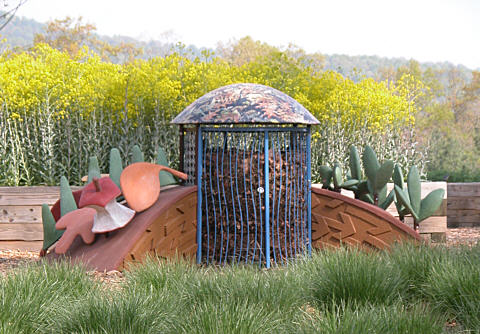
All images and text copyright Martin Webster, all rights reserved.

All images and text copyright Martin Webster, all rights reserved.

CompoStorium 11' x 6' x 4'
Artist's Statement, short version: Artist's Statement, full version: The CompoStorium is offered as one way to help fill this gap. It is a ceremonial site in the spirit of ancient Middle Eastern and Meso-American temples and burial chambers, which were intended to symbolize and illuminate the mysteries of the transition to the afterlife. Through murals, reliefs, statuary, and the architectural forms themselves, these structures sought to teach lessons about the builders' understanding of how the world works. The structures did not undertake to tell the whole story, but rather to present a combination of recognizable imagery with stylized elements in an aesthetic whole that could serve as a springboard for a priest or teacher to explain the details to an interested learner. The central element of the CompoStorium - a functional compost bin - is the domed chamber, its form reminiscent of classical temples. On either side are ramps like grand temple staircases or like the pyramids of Egypt, Mesopotamia, and the Aztecs. On the sides of the ramps are the arrows of the great cycle, which by implication returns to the beginning. The entrance ramp begins wide to funnel the detritus of fallen organisms into the compost pile, a balance of carbon-rich and nitrogen-rich materials. The entrance to the chamber is through jagged forms that remind that shredding the materials exposes more surface area to accelerate the composting process. The chamber's openwork walls are flowing forms suggesting the essential balance of moisture and air to encourage the aerobic organisms that most efficiently do the work of composting. The protective dome evokes the easiest place to watch Nature's composting in action: the forest floor. The exit ramp illustrates the payoff from dispersal of the resulting compost: lush, diverse plant growth from healthy soil. During its exhibition at The North Carolina Arboretum, the CompoStorium will be a working bin, processing materials from the Arboretum and from the artist's Yancey County farm. At the time of installation, a soil sample from the site will be sent to Soil Foodweb, Inc., (a specialized laboratory established by Dr. Elaine Ingham in Corvallis, Oregon) to obtain an assay of the species of soil life and their numbers present in the soil. Near the end of the exhibition, a sample of the compost itself will be sent for a similar assay, to document the surge of life promoted by the hospitable conditions of the CompoStorium. Thus during its exhibition the CompoStorium will literally be cultivating a living treasure: those mostly invisible organisms whose services are fundamental to the rest of life. Paleontologist Andrew H. Knoll says that complex plants and animals may be the icing on the cake of life on earth, "but bacteria are the cake." Bacteria, fungi, actinomycetes, protozoa, microarthropods, and other creatures tiny and not so tiny will thrive in the CompoStorium. What will also thrive is the opportunity for curious individuals to learn more about the compost story and gain an appreciation and even reverence for these little renewers of life. Citizens who are aware of and protective of Nature's cycles in their daily lives and in their communities are themselves living treasures. |